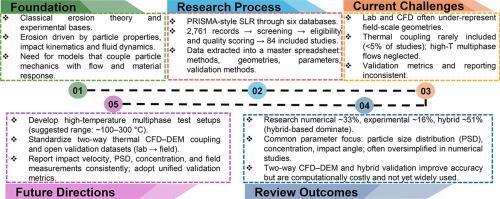材料侵蚀预测技术的系统回顾:结合模型参数的可变性和缺乏现场尺度表示
IF 7.9
Q1 ENGINEERING, MULTIDISCIPLINARY
引用次数: 0
摘要
由于颗粒特性、流动条件和现场几何尺寸近似的影响,工业流设备固体颗粒侵蚀的精确预测仍然是一个持续的挑战。本研究根据PRISMA 2020指南进行了系统的文献综述(SLR),其中从六个主要学术数据库中获得了主要记录集。经过重复丢弃、两阶段标题/摘要/关键词筛选和合格性/质量评估,纳入84项研究。这些包括的记录分为纯数字方法(33%)、纯实验方法(16%)和混合数字实验方法(51%),揭示了计算成本、机制一致性和经验精度之间的明显差异。然后,我们分析了如何通过这些方法调整颗粒大小,浓度,冲击角度和速度。在基于数值的研究中观察到对颗粒大小和小浓度的常见简化;而基于混合的研究使用了更真实的分布。场尺度几何通常由实验室尺度的流环或简化的板或板来近似,只有少数研究结合了重力效应或真实的场尺度尺寸表示。此外,流体-介质温度对侵蚀的影响仍然主要被忽视,尽管众所周知热耦合对材料表面侵蚀和流体粘度降低有影响,但纳入的研究中只有不到5%考虑了热耦合。我们的研究结果强调了关键的文献空白,特别是对温度相关研究和改进的现场尺度尺寸验证的必要性,并为未来的研究提出了建议,包括选择通过更具现场代表性的实验装置验证的双向耦合CFD-DEM模型。本文章由计算机程序翻译,如有差异,请以英文原文为准。

A systematic review of material erosion prediction techniques: Incorporating model parameters variability and the lack of field-scale representation
The precise prediction of solid particle erosion of industrial flow equipment remains a constant challenge due to the effects of particle properties, flow conditions, and approximation of field-scale geometries. This research offers a systematic literature review (SLR), following the PRISMA 2020 guidelines, in which a primary collection of records was obtained from six major scholarly databases. After duplicate discard, two-stage title/abstract/keywords screening, and eligibility/quality assessment, 84 studies were included. These included records were categorized into purely numerical-based (33%), purely experimental (16%), and hybrid numerical–experimental (51%) approaches, revealing distinct variations between computational cost, mechanistic consistency, and empirical precision. We then analyzed how particle size, concentration, impact angle, and velocity have been adapted through these approaches. A common simplification to particle size and small concentrations was observed in numerical-based studies; whereas hybrid-based studies used more realistic distribution. Field-scale geometries were commonly approximated by laboratory-scale flow loops or simplified coupons or plates, with just a few studies incorporating gravity effects or real field-scale dimensional representation. In addition, fluid-medium temperature effects on erosion remain predominantly ignored, with less than 5% of included studies integrating thermal coupling in spite of its well-known effect on material surface erosion and fluid viscosity reduction. Our findings underline crucial literature gaps—especially the necessity for temperature-dependent investigation and improved field-scale dimensional validation—and put forward recommendations for future research, including the selection of two-way coupled CFD–DEM modeling validated with more field representative experimental setups.
求助全文
通过发布文献求助,成功后即可免费获取论文全文。
去求助
来源期刊

Results in Engineering
Engineering-Engineering (all)
CiteScore
5.80
自引率
34.00%
发文量
441
审稿时长
47 days
 求助内容:
求助内容: 应助结果提醒方式:
应助结果提醒方式:


